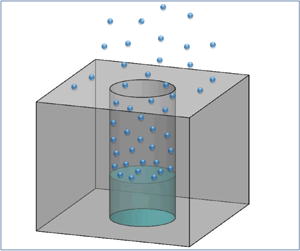Article contents
Theoretical and numerical study of nanoporous evaporation with receded liquid surface: effect of Knudsen number
Published online by Cambridge University Press: 04 October 2021
Abstract

The liquid evaporation from nanoscale pores has attracted much attention from researchers due to its importance in water treatment and device cooling related applications. It is crucial to investigate the receded liquid case as the vapour flow resistance in a nanopore has high impacts on the evaporation rate. This paper proposed a semi-empirical analysis on nanoporous evaporation with a receded liquid surface under the influence of the Knudsen number. The vapour flow dynamics in a nanopore was examined considering the multiple reflections of vapour molecules. We calculated the value of pore transmissivity based on transitional gas flow correlation which incorporated the effect of the Knudsen number. Direct simulation Monte Carlo method was employed to provide validation for the present model. The vapour density jump near the liquid surface and the pressure ratio between the far field and saturation value were predicted by our model with good precision. It was shown that the vapour flow resistance in the nanopore accounted for more than 90 % of the total resistance in present cases. With increasing Knudsen number, the pressure ratio gradually drops and reaches an asymptotic level. This suggested a relatively higher evaporation resistance in free molecular regimes. The present work revealed the importance of the Knudsen number in nanoporous evaporation with receded liquids, providing insights into the governing factors under various Knudsen regimes.
- Type
- JFM Papers
- Information
- Copyright
- © The Author(s), 2021. Published by Cambridge University Press
References
- 11
- Cited by



